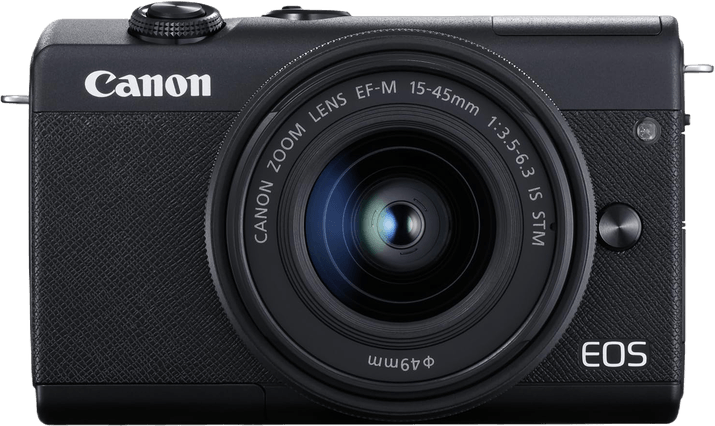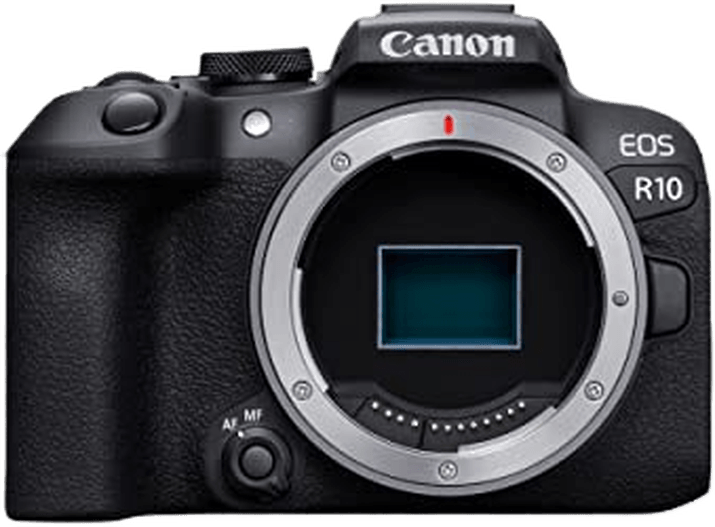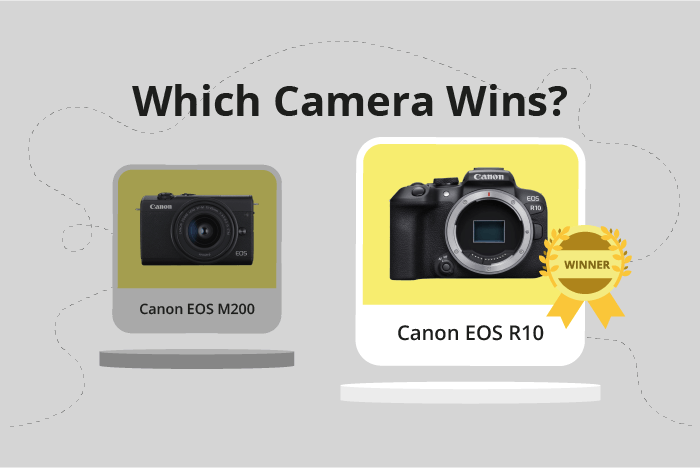Canon EOS M200 vs EOS R10 Comparison
Canon EOS M200

Canon EOS R10

The Canon EOS R10 emerges as the winner with a score of 69/100, while the Canon EOS M200 trails behind at 62/100. Both cameras are mirrorless and share some common specifications. However, the EOS R10, launched in 2022, is a more advanced model compared to the EOS M200, released in 2019.
One advantage of the R10 is its larger size (123 x 88 x 83mm) compared to the EOS M200 (108 x 67 x 35mm), which may provide better handling for some users. However, the EOS M200 is significantly lighter at 229g (0.50lbs), making it more portable than the EOS R10, which weighs 426g (0.94lbs).
While the EOS R10 offers superior performance, the EOS M200 serves as a more affordable and lightweight option for those prioritizing portability. Ultimately, the choice depends on individual preferences and requirements.
Canon M200 vs R10 Overview and Optics
The Canon EOS R10 outperforms the Canon EOS M200 in optics with a score of 71/100 compared to the M200’s 63/100. Both cameras share several specifications, such as having 24 megapixels, a CMOS sensor type, APS-C sensor size, and no image stabilisation.
The EOS R10’s superiority in optics is evident in its faster shooting speed and a more advanced processor. The R10’s shooting speed of 15 is significantly faster than the M200’s 6.1, allowing for better action and sports photography. Additionally, the R10 features a more advanced Digic X processor, which contributes to improved image quality and processing speed. Lastly, the R10’s sensor receives a DXOMARK score of 97, considerably higher than the M200’s 58, indicating better overall image quality.
The M200 does not outshine the R10 in any specific optics-related aspect. However, it is worth noting that the M200 uses the Canon EF-M lens mount, while the R10 uses the newer Canon RF lens mount. The EF-M mount offers a more extensive selection of compatible lenses, which could be beneficial for those with existing EF-M lenses or seeking more affordable lens options.
Taking all factors into account, it is evident that the Canon EOS R10 provides better optical performance than the Canon EOS M200. With its faster shooting speed, more advanced processor, and high DXOMARK sensor score, the R10 is the clear winner in this comparison. The M200’s advantage lies in its compatibility with a broader range of lenses, but this does not outweigh the overall superiority of the R10 in terms of optics.
Canon EOS M200 vs EOS R10 Video Performance
The Canon EOS R10 emerges as the winner in video capabilities, scoring 91/100, while the Canon EOS M200 lags behind with a score of 83/100. Both cameras share some common specifications, including a maximum video resolution of 4K and dimensions of 3840 x 2160. Additionally, both cameras come with built-in time-lapse functionality.
The winning camera, the Canon EOS R10, outperforms the Canon EOS M200 in terms of maximum video frame rate. The R10 can reach up to 120fps, which allows for smoother and more detailed slow-motion footage. This higher frame rate is a significant advantage for those who prioritize capturing fast-paced action or creating professional-quality videos.
On the other hand, the Canon EOS M200 does not offer any specific advantages in video capabilities compared to the Canon EOS R10. Both cameras share the same maximum video resolution, dimensions, and time-lapse functionality. The only difference lies in the maximum video frame rate, where the M200 falls short with a maximum of 60fps.
Taking these factors into account, the Canon EOS R10 is the superior choice for video capabilities due to its higher maximum video frame rate. The Canon EOS M200 still offers competitive video features, but the R10’s 120fps frame rate sets it apart as the better option for those seeking advanced video performance. Therefore, the Canon EOS R10 is the clear winner in this comparison, while the Canon EOS M200 remains a solid choice for those with less demanding video needs.
Canon EOS M200 vs EOS R10 Features and Benefits
The Canon EOS M200 and Canon EOS R10 both have a feature score of 70/100, making them equal in this aspect. They share several specifications, including a 3-inch screen size, 1,040,000-dot screen resolution, touchscreen functionality, flip screen, and the absence of GPS. Both cameras also come with WiFi and Bluetooth capabilities.
The Canon EOS M200 is not superior to the Canon EOS R10 in terms of features, as they have the same score and identical specifications in this area. There is no clear winner between these two models based on their features alone.
Similarly, the Canon EOS R10 does not surpass the Canon EOS M200 in any specific feature, as they share the same specifications. As a result, neither camera can be considered better in this comparison.
Since the Canon EOS M200 and Canon EOS R10 have the same feature score and specifications, potential buyers should consider other factors, such as price, body design, and personal preferences, when choosing between these two models. The choice between the Canon EOS M200 and Canon EOS R10 ultimately depends on individual needs and priorities, as their features are indistinguishable.
Canon EOS M200 vs EOS R10 Storage and Battery
The Canon EOS R10 outperforms the Canon EOS M200 in storage and battery, with a score of 40/100 compared to the M200’s 21/100. Both cameras share some common specifications, including a single memory card slot and compatibility with SD, SDHC, and SDXC (UHS-I) memory cards.
The R10’s superiority lies in its longer battery life and USB charging capability. With the LP-E17 battery, the R10 can capture up to 450 shots, while the M200’s LP-E12 battery allows for only 315 shots. Additionally, the R10’s USB charging feature provides users with a convenient charging option.
While the M200 falls short in battery life and charging options, there are no specific advantages it holds over the R10 in the storage and battery category.
Considering these factors, the Canon EOS R10 proves to be the better choice in terms of storage and battery performance, offering users extended shooting time and increased charging flexibility.
Canon EOS M200 vs EOS R10 – Our Verdict
Are you still undecided about which camera is right for you? Have a look at these popular comparisons that feature the Canon EOS M200 or the Canon EOS R10:

